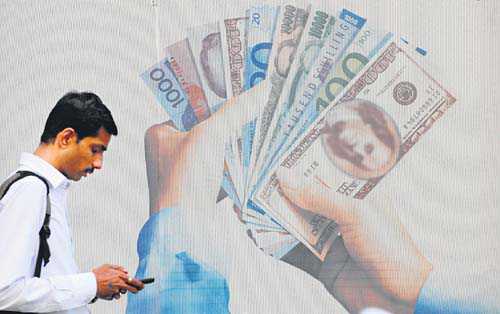
After the Federal Reserve lifted interest rates the first time in a decade, Asian stock markets rallied. The long-term effect of the measure, however, remains to be seen. AFP
Arun Kumar
THE year 2015 is ending with good news for the government with the mid-term economic review predicting that the economy will achieve 7.5 per cent growth. It is less than expected earlier but makes India the world's fastest-growing economy. The news on the industrial front suggested an uptick. However, the services sector is not doing so well and the export front is dismal. The uncertainty about the impact of an increase in the interest rates in the US is over but its long-range impact will slowly play itself out in the coming months. So, the NDA has something to cheer about in the midst of many negatives.
During the Parliament debate on intolerance, the NDA was on the defensive. Everyone agrees that intolerance not only hurts India but also spoils its image abroad, thereby having a negative economic impact. Moody's Analytics warned India against following a narrow agenda due to this reason. This is not an isolated view since the US State department, Zubin Mehta and others have raised similar concerns.
The Government got a pat on the back when India's “brand value” improved by one rank over last year to seventh and India jumped 12 ranks to the 130th position among 189 countries in “Ease of Doing Business”. The Finance Minister is not too pleased with this low rank and felt it should have been higher.
The NDA's claim of better economic performance is being overshadowed by the rising criticism of the sectarian and divisive agenda. Intellectuals of various hues have protested and there is bad press. Just like Volkswagen lost brand value after it was found to have fixed the software to show lower emissions in its diesel vehicles, India has also lost “brand value” due to the rising civil strife.
Brand valuation of a nation is problematic. A product or a company is simpler to value since their income stream is commercially defined. But how does one do that for a nation?In the case of a branded product, the owner of the brand gets an income as royalty from the producer and this is used to value the brand. But, to treat a nation as a “brand” and get the income earned is problematic.
Brand Finance publishes the “brand value” of nations. Its website informs us that it uses a Brand Strength Index (BSI), based on three broad factors, with each given equal weight. They are infrastructure and efficiency, brand equity and economic performance. Each of these is itself a composite of other factors, like quality of workforce and ability to attract foreign talent. It appears that the growth of the economy plays a major role. Further, these indices are based on perceptions and Government data and this is where the problems arise.
In India, the GDP growth data has been challenged since the new series was released last January. It showed a jump in growth rate in the preceding two years. This led to an improvement in the country's image and to an improved “brand value”. India's story is important given that the other big economies are sputtering or slowing — Eurozone, Britain, USA and the BRICS (minus India). This is the source of the positive sentiment about India. However, what if the GDP growth story is incorrect?
Industry has hardly grown in the last three years. The unorganised and small-scale sectors are complaining. While e-commerce has done well, it is at the expense of the brick-and-mortar traders. Agriculture is facing its second drought in a row. Exports have been declining for the last one year. Consumer demand has been sluggish and the investment rate in the economy is down to about 28-30 per cent in the last two years from its peak of 38 per cent in 2008. Both public and private sector investments have stagnated due to cuts in plan expenditures and spare capacity, respectively.
The Indian investment story stalled during the UPA II rule due to policy paralysis on the back of corruption charges and the policy makers playing safe. Matters have hardly improved due to over-centralisation of power in the PMO under the NDA rule and files getting stuck there. Further, while policies are being announced, the roadmap is often not clear. As journalist Arun Shourie has said, businesspersons are privately complaining, while in public they dare not speak.
Growing social strife on the back of the communal agenda being pushed is adding to the disenchantment of businesses. Fringe elements making rabid statements when their mentors were not in power was one thing but now this cannot be ignored when ministers and senior party people back them. All this negatively impacts investment sentiment as well as India's “brand value”. The GDP data is vitiated by the growing black economy, which while raising the rate of growth of the economy simultaneously results in poor governance and policy failures.
It lowers the “brand value” and adversely impacts “ease of doing business” by bringing about non-transparency.
This factor is not taken into account in calculating India's “brand value”. For instance, if roads are considered it is not just the quantum that matters but also the quality. Indian roads are largely in poor shape so that vehicles gets damaged. The quality of education and health is poor even though its reach has increased. Thus, with poor skill levels, there is unemployability and doing business becomes difficult. Just as the Chinese economy has slowed down given the international economic situation, so could the Indian economy. The Indian economy, at about $2.2 trillion, is about 3.5 per cent of the world GDP and, therefore, cannot be the engine of growth for the world.
In the coming year, India would have to depend on the internal market for its growth just as China has realised this fact. For that, the Government would have to help reduce the rapidly growing inequity to boost demand. But such steps could be mistaken for being anti-business. The Government would have to also increase expenditures on education and health but the last Central budget has moved in the opposite direction.
Internal investments have to be increased because foreign investment is about 10 per cent of the total and any rise there cannot compensate for the 10 per cent decline in total investments since 2008. The private sector would not invest more as long as spare capacity persists and the social climate remains adverse. Investments depend on expectations and the social factors affect it. Investment in the infrastructure sector poses problems because private players who invested in this sector have borrowed heavily and are saddled with loans they are unable to repay, leading to NPAs for the banks. These difficulties need to be resolved if investments are to rise. Brand valuation” etc., will not matter unless there is a basic rethink of current policies. If not, even the bit of good news for the government could turn negative. It needs to realise that what it thought was the solution is really the problem.
The writer is a former Professor of Economics, JNU & author of “Indian Economy since Independence: Persisting Colonial Disruption”.



























